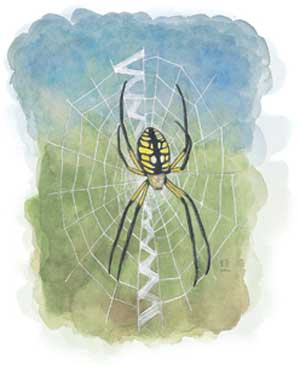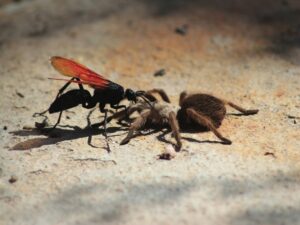Things begin rumbling about now. Storm clouds pile up along the outer Coast Ranges, the winds shift and come out of the south, days get shorter, and the air gets colder. October days might often be sunny and warm–and the hills are the brownest and driest they’ll be all year–but we all know what’s coming: the rainy season.
Underground, the termites know it too. Millions of drones (males) and virgin queens grow wings, ready to burst from their subterranean lairs in nuptial flights to form new colonies.
- Termites live mostly underground (or in our walls!) but aswinter approaches, they grow wings and take to the air in droves toform new colonies. Illustration by Erin Hunter
Be on the lookout for tell-tale signs that termites are on the move—dragonflies darting in close maneuvers over a clearing, or jays and sparrows swooping down to snatch emerging termites on the wing. Tiny earthen chimneys scattered around the ground are remnants of their launch pads. Look for tiny gossamer wings littered over the ground as the emerging insects shed their temporary flight gear for life underground. No need to find a special park for this event: Termite emergence happens throughout the Bay Area—in backyards, parking lots, and fields, and on roadsides.
Fall is also the best season for spider watching, and the two most obvious and numerous kinds here are both orb weavers: Araneus species, often called pumpkin spiders, and Argiope auarantia, the black, silver, and yellow orb weavers. Fall is when these orb weavers are mature and ready to lay eggs. (Most live only for a season, and laying eggs is their last act. Remember Charlotte’s Web?) Argiope prefers dense vegetation to snare incoming insects. Its web has a classic zigzag zipper running through the middle from 12 o’clock to 6 o’clock. Araneus prefers to build its snares in openings where breezes serve as a jet stream for flying insects. It hides away in an upper crevice of the web during the day and positions itself smack dab in the center of the hub at night.

- In the fall, orb weaver spiders like this one spin webslarge enough for us to notice, often when we walk right into them! Illustration by Erin Hunter
Our most notable fall spider is the tarantula, and fall is its mating season in the parched environs of the East Bay hills. Head to such regional parks as Las Trampas, Sunol, Del Valle, or Pleasanton Ridge to see these lumbering giants parading across the trails searching for mates. In the South Bay, tarantulas are common at Coyote Reservoir, Joseph D. Grant County Park, and Henry W. Coe State Park.
Get Out!
What better place to get to know tarantulas than in their own stomping grounds? Every year, Bay Area naturalists take advantage of the spiders’ seasonal wanderings to lead tarantula hikes on the slopes of Mount Diablo. Naturalist Ken Lavin has a free, all-ages “Tarantula Trek” on October 8 [3-6 p.m., $3 parking fee, info: (925)686-9393]. Walnut Creek’s Lindsay Museum is offering a tarantula walk on October 7 for adults and children 8 and up with naturalist and teacher Bob Love [4:30-7 p.m., $10 members/$20 nonmembers, info: (925)935-1978].
If you miss those outings, you can still find tarantulas—along with snakes, rats, and other supposedly scary critters—at Sulphur Creek Nature Center’s annual “Unhaunted House” on October 28 and 29 in Hayward [info: www.haywardrec.org; (510)881-6747]. Museums such as the Randall in San Francisco, Coyote Point in San Mateo, and Lindsay in Walnut Creek offer hands-on exhibits to learn more about spiders and insects.
You can also learn more about fall bugs right at home. Head to your backyard or local park and take a closer look at any woody debris littering the ground—fallen branches, discarded lumber—or a dying tree trunk. If the wood is decomposing, you’ll probably find the wiggly paths that termites burrow through wood. To watch an orb weaver spider catch its prey, look in large stands of blackberry bushes or other shrubs for signs of these colorful creatures and their thick-stranded webs. Hooked on bug-watching yet? Click here to learn how to put together a family discovery pack that will seal the deal.

.jpg)




